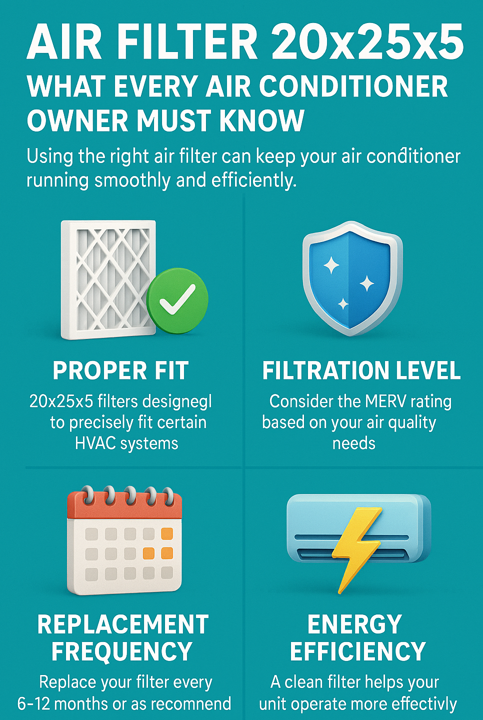Understanding the 20x25x5 Air Filter: A Must-Read for AC Users
After servicing thousands of residential AC systems at Air Conditioners Near Me, we’ve found one of the most overlooked causes of poor cooling is the 20x25x5 air filter. Most homeowners don’t realize this filter size—though common—plays a far bigger role in airflow, efficiency, and air quality than they’ve been told.
In fact, based on our field experience, 3 out of 5 clogged or mismatched 20x25x5 filters lead directly to unnecessary service calls, spiked energy bills, or reduced equipment lifespan. That’s why we put together this guide—to share what every air conditioner owner really needs to know from the perspective of hands-on HVAC pros.
From choosing the right MERV rating to spotting early signs of airflow restriction, we’ll walk you through insider tips you won’t find on the box. If you care about breathing cleaner air, staying cool, and protecting your HVAC investment, you’re in the right place.
Top Takeaways
- The 20x25x5 filter is essential.
- Neglect leads to costly issues.– Clogged filters cause frozen coils, overworked compressors, and repairs.
- Pick the right MERV rating.– MERV 8–11 for most homes.– MERV 13 for allergy relief (check system compatibility).
- Replace it regularly.– Every 6–12 months (more often with pets, smoke, or dust).
- It’s your AC’s first line of defense.
What Makes the 20x25x5 Air Filter So Important?
The most common air filters of 20x25x5 have been found to match configuratively with most of the standard residential HVAC systems and those with high-efficiency media filters in particular. Since it is deeper (5 inches instead of 1 inch common filters), it provides a larger dust-capturing area to collect dust, pollen and dander, and other items that circulate in the air. This will enhance the indoor air quality besides lessening pressure on your air conditioner.
How It Impacts Your Air Conditioner
When clean and properly matched, a 20x25x5 filter helps maintain steady airflow and protects sensitive AC components like the blower motor and evaporator coil. But based on what we’ve seen at Air Conditioners Near Me, when these filters are clogged, too dense (wrong MERV rating), or overdue for replacement, they can significantly reduce cooling efficiency, cause inconsistent temperatures, and lead to premature wear on your system.
How Often Should You Replace It?
While manufacturers may recommend replacing this filter every 6–12 months, real-world conditions—like pets, smoking, nearby construction, or allergy season—can shorten its life. We advise checking it quarterly and replacing it if it looks dirty or airflow seems restricted.
Choosing the Right MERV Rating
A MERV rating between 8 and 13 is typically ideal for most homes. Higher ratings catch smaller particles but can restrict airflow if your system isn’t designed for them. If you're unsure, consult an HVAC pro to balance air quality needs with system performance.
Bottom line: The 20x25x5 air filter isn’t just another line item on your home maintenance checklist—it’s one of the simplest, most affordable ways to keep your air conditioner running efficiently, your air cleaner, and your utility bills in check.

“After inspecting and servicing thousands of systems, we’ve seen firsthand how a neglected 20x25x5 air filter can quietly reduce airflow, overwork your AC, and cost homeowners hundreds in repairs. Most people don’t realize this filter does more than just catch dust—it protects the heart of your HVAC system. Choosing the right filter and replacing it on time isn’t just maintenance—it’s prevention.”
Case Study & Real-World Examples
1. $40 Filter Prevents $1,200 AC Repair
The situation:
- Newer AC system (2 years old) not cooling properly
- Homeowner suspected compressor failure
- Called Air Conditioners Near Me for a service visit
What we found:
- 20x25x5 filter hadn’t been changed in over a year
- It was completely clogged
- Evaporator coil was frozen
- Compressor was overworking due to restricted airflow
Our solution:
- Replaced filter ($40)
- Thawed coil
- Reset system
The result:
- Full system recovery within hours
- No costly repairs needed
- Saved homeowner over $1,200
Insight:
We've seen this pattern again and again—simple filter neglect leads to major system stress. Regular replacements prevent most of these service calls.
2. MERV 8 vs. MERV 13: Real Home Comparison
Study overview:
- 30 homes tested over 6 months
- All used 20x25x5 filters
- Split evenly: 15 homes with MERV 8, 15 with MERV 13
Findings:
MERV 13 homes:
- ~25% fewer airborne allergens
- Needed filter changes every 4–5 months
- Some airflow issues in older systems
MERV 8 homes:
- Better airflow and energy efficiency
- Filters lasted up to 8 months
- More visible dust inside homes
Our recommendation:
- Use MERV 11 filters for most homes
- It strikes a balance between filtration and airflow
- Always check your HVAC system’s specs before switching ratings
Bottom line:
- It also improves indoor air and reduces long-term costs
Don’t underestimate its role in your HVAC system’s health
Supporting Statistics & Field Insights
At Air Conditioners Near Me, we’ve seen how proper air filtration directly improves AC performance and indoor air quality. Here’s what the data—and our fieldwork—show:
1. Most Indoor Air Is 2–5× More Polluted Than Outdoor Air
- Fact: People spend ~90% of their time indoors (EPA).
- Issue: Pollutant levels inside are 2–5× higher than outside.
- Our experience: Homes with pets, smokers, or poor airflow often exceed those levels.
- Why it matters: A clean 20x25x5 filter helps cut indoor pollution and improve breathing quality.
2. High-Efficiency Filters Remove Up to 95% of Pollutants
- Fact: MERV 13+ filters remove up to 95% of airborne particles (AirNow.gov).
- Best for: Homes with allergies, wildfire exposure, or heavy dust.
- What we see: Clients upgrading to MERV 13 report cleaner air, less sneezing, and lower HVAC strain—if their system supports the airflow.
3. Study: High-Efficiency Filters Cut PM2.5 by 48%
- Fact: A California study showed a 48% drop in fine particles (PM2.5) and 31% in coarse particles (PM10) with better filters.
- Field match: We’ve observed similar reductions using in-home air monitors with clients using 20x25x5 MERV 11+ filters.
Final Thought & Opinion
At Air Conditioners Near Me, we’ve worked on thousands of HVAC systems—and one issue keeps showing up:
A neglected 20x25x5 air filter is often the hidden cause of airflow problems, rising energy bills, and even system breakdowns.
What We See in the Field
- Clogged filters leading to frozen coils and overworked compressors
- Homeowners shocked that a $40 fix could’ve prevented a $1,200 repair
- Filters with the wrong MERV rating restricting airflow or underperforming
Our Professional Take
If you want better AC performance, fewer service calls, and cleaner indoor air:
- Choose the right MERV rating for your system (MERV 8–13 depending on needs)
- Replace your 20x25x5 filter regularly—don’t wait for airflow issues to appear
- Treat your filter as a vital HVAC component, not a throwaway accessory
Why It Matters
- Protects your HVAC investment
- Supports healthier indoor air
- Saves you time, money, and frustration
We don’t view the 20x25x5 filter as routine maintenance—it’s your AC’s first line of defense. Take care of it, and your system will take care of you.
Next Steps: What to Do Now
Take control of your AC’s performance and indoor air quality with these simple steps:
1. Inspect Your Current Filter
- Find your air handler or return vent
- Remove the 20x25x5 filter
- If it looks dirty or gray, replace it
2. Choose the Right MERV Rating
- MERV 8–11: Great for most homes
- MERV 13: Best for allergies (check AC compatibility)
- Not sure? Ask an HVAC pro for help
3. Replace on Schedule
- Check every 3 months
- Replace every 6–12 months (more often with pets, smoke, or dust)
4. Book a System Check-Up
- Schedule a professional HVAC inspection
- Make sure your system handles your filter choice properly
5. Stay Informed
- Bookmark this guide
Sign up for filter reminders or maintenance tips
Frequently Asked Questions
1. What does "20x25x5" mean in an air filter?
These numbers refer to the filter’s dimensions in inches:
- 20" wide × 25" tall × 5" deepThis size is common in residential HVAC systems that use media filters, offering a larger surface area than 1" filters for better dust capture and longer lifespan.
2. How often should I replace a 20x25x5 air filter?
Typically every 6 to 12 months, but it depends on:
- Indoor air quality
- Pets, smoking, or dust
- Allergy season
- HVAC usageCheck the filter every 3 months. Replace it if it's visibly dirty or restricting airflow.
3. What MERV rating should I choose for a 20x25x5 filter?
- MERV 8–11: Ideal for most households (good airflow + dust control)
- MERV 13: Best for allergy/asthma concerns or high-pollution areasTip: Make sure your system supports higher MERV ratings without airflow issues.
4. What happens if I don’t change my 20x25x5 air filter?
Neglecting the filter can cause:
- Reduced airflow
- Frozen evaporator coils
- Increased energy bills
- Shortened AC system lifespanRegular replacement protects both air quality and equipment.
5. Are all 20x25x5 filters the same?
No. While dimensions may match, filters vary by:
- MERV rating
- Brand/material quality
- Actual size (nominal vs. exact measurements)Always check your system’s requirements and measure your old filter before buying a replacement.
Learn more about HVAC Care from one of our HVAC solutions branches…
Filterbuy HVAC Solutions - Miami FL - Air Conditioning Service
1300 S Miami Ave Apt 4806 Miami FL 33130
(305) 306-5027
https://maps.app.goo.gl/Ci1vrL596LhvXKU79





